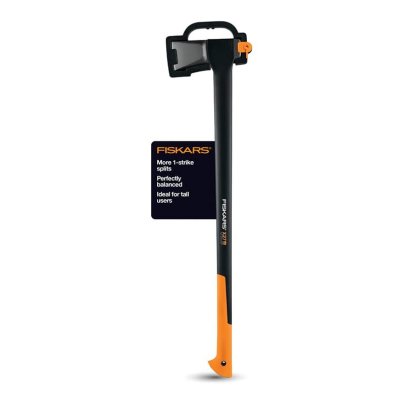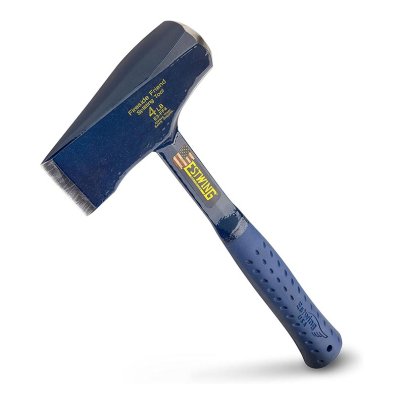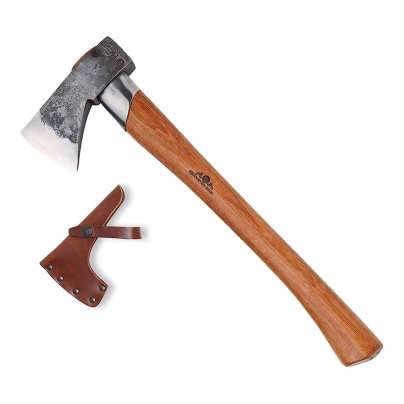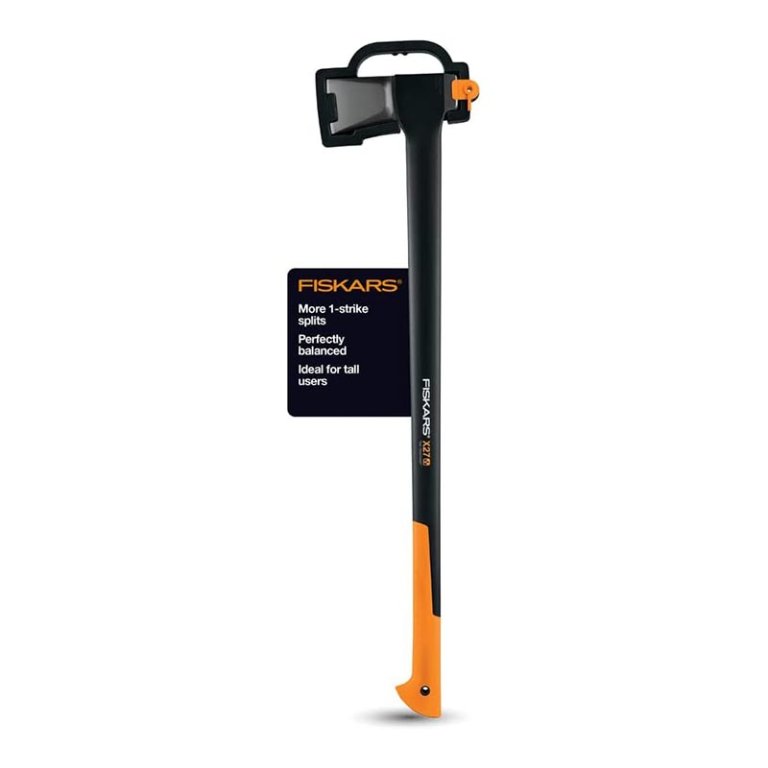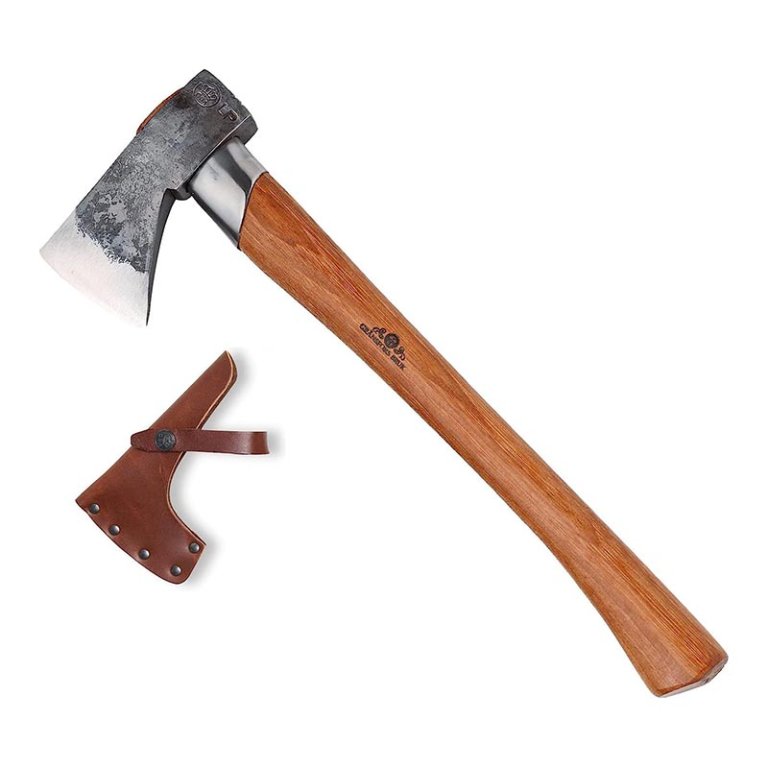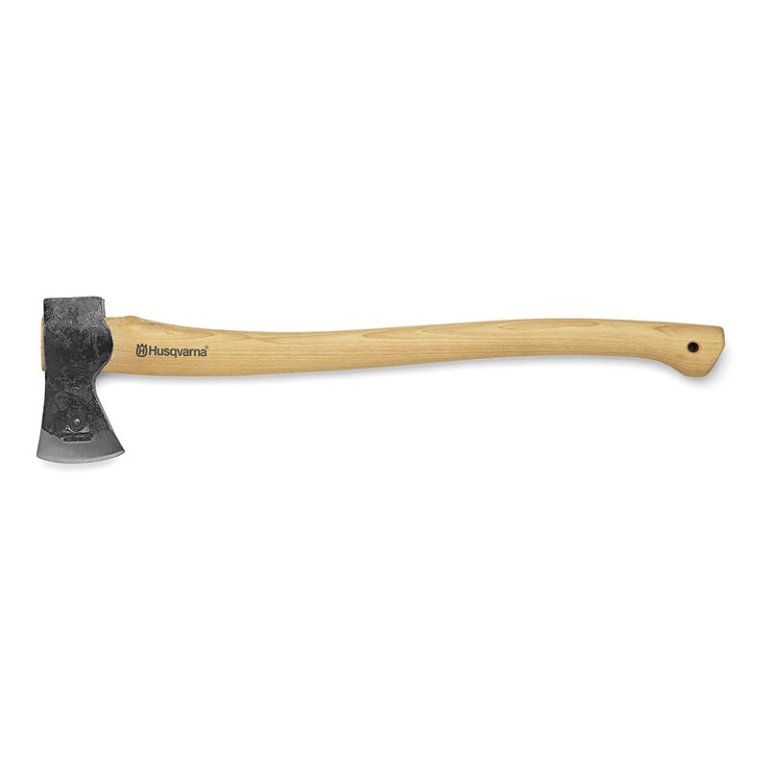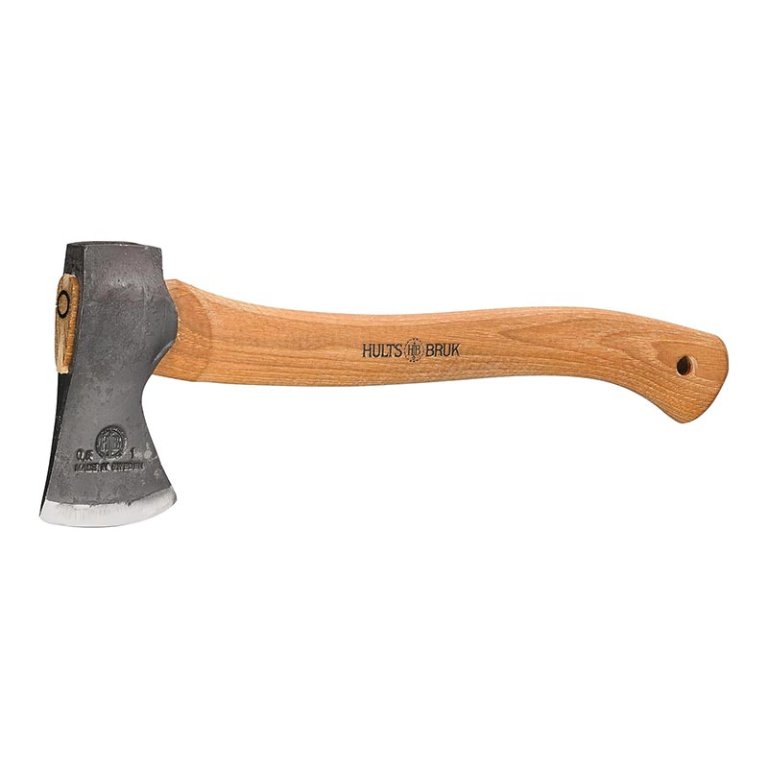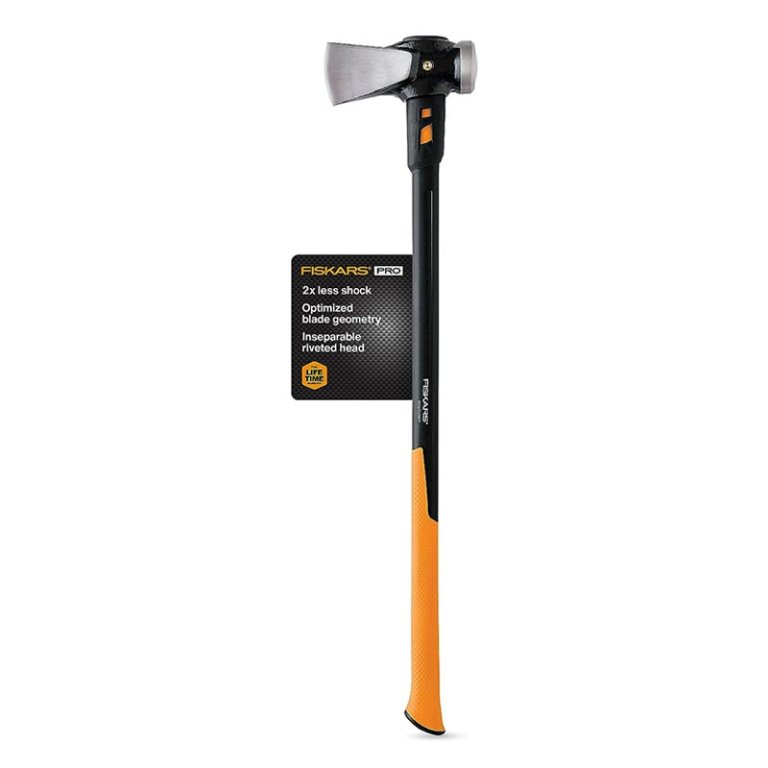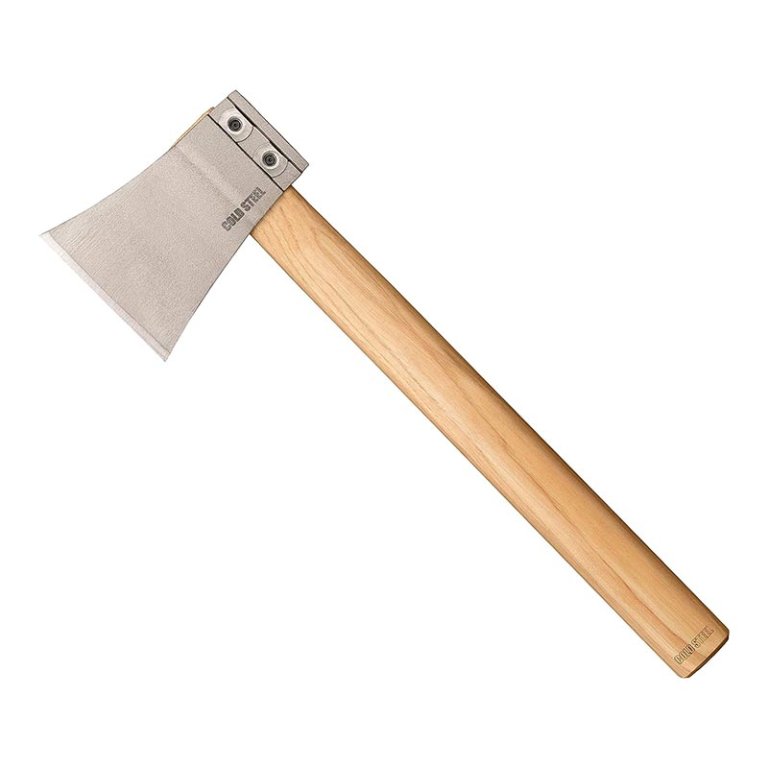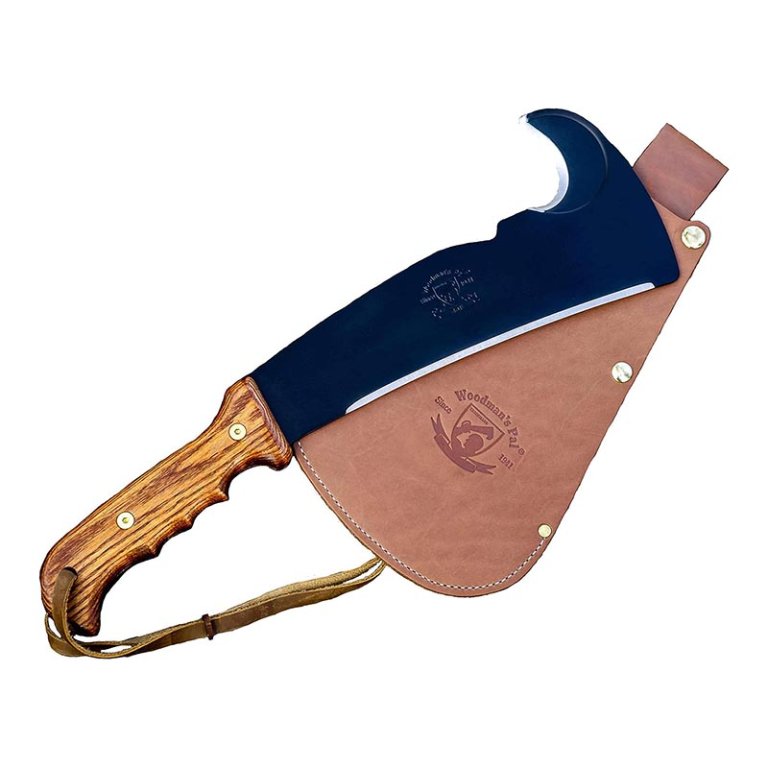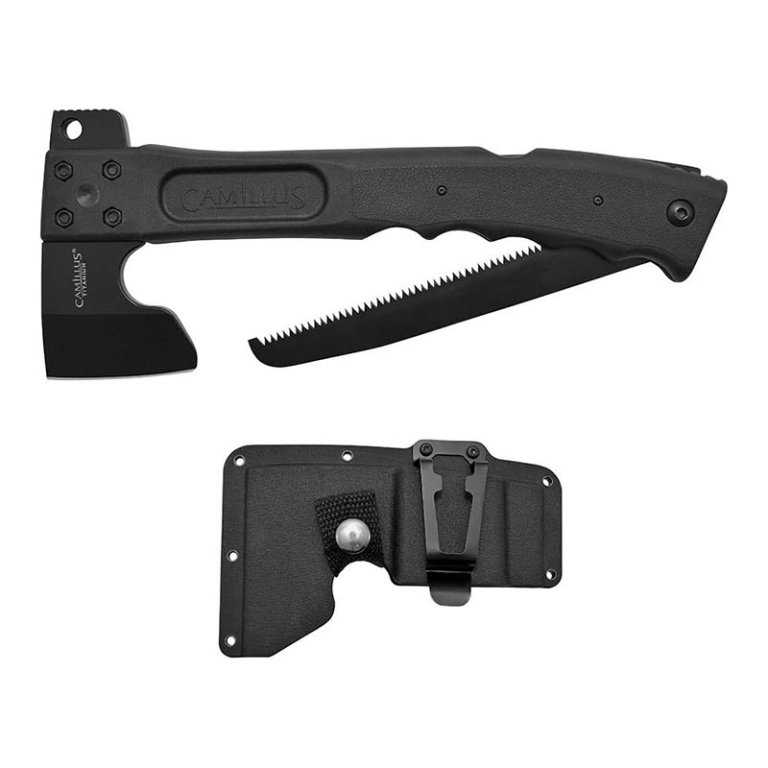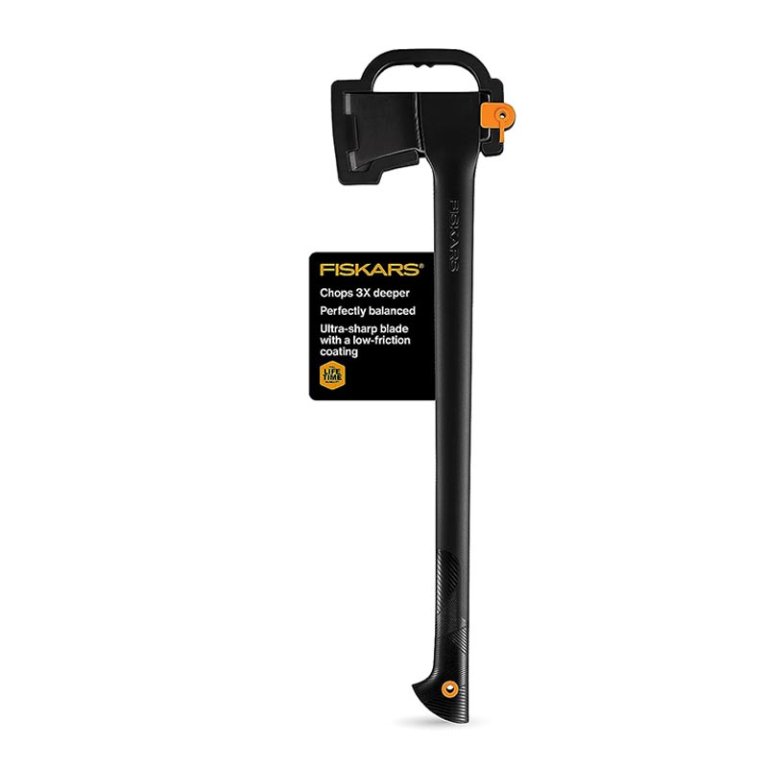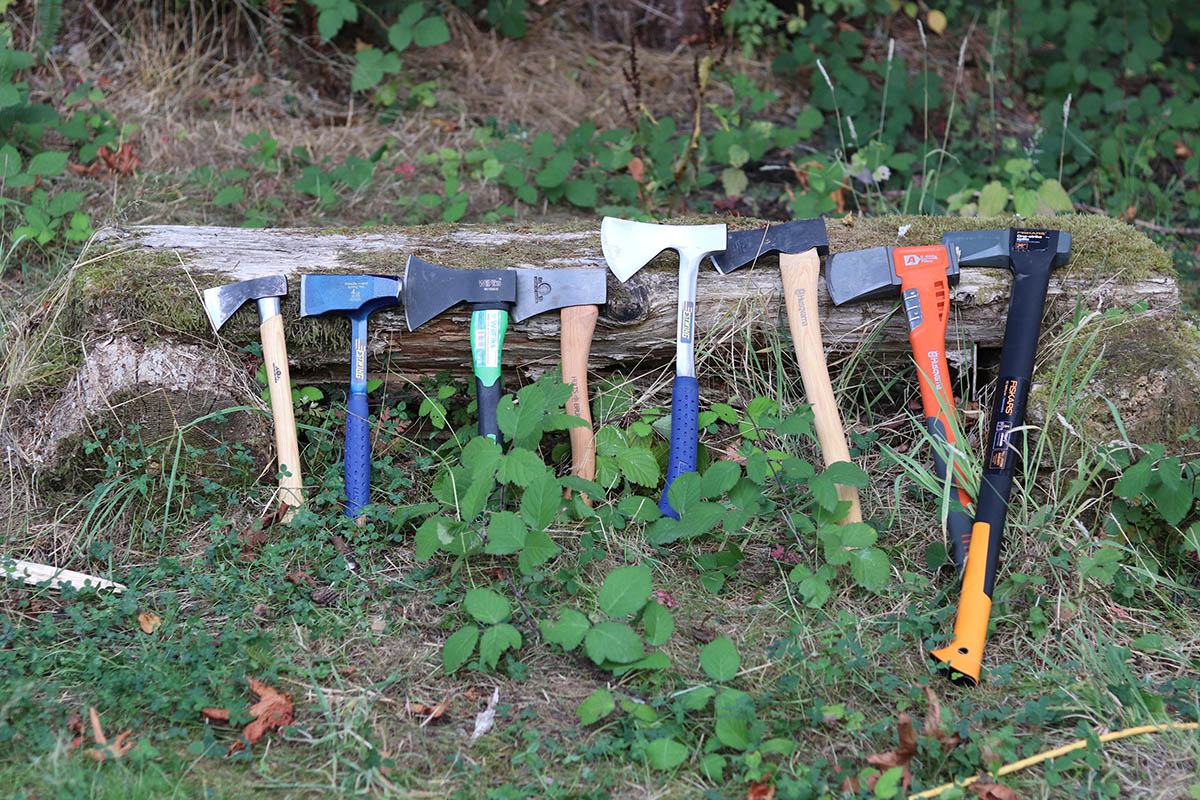
We may earn revenue from the products available on this page and participate in affiliate programs. Learn More ›
Buying firewood to enjoy the warmth of a wood-burning fireplace can be expensive, but you can offset that cost by purchasing your own axe if you’re lucky enough to have oak, maple, or ash trees and the know-how to harvest and split your own firewood. A cord, which measures 8 feet long by 4 feet wide by 4 feet deep or 128 cubic feet, can run as much as $400, depending on where you live. If you are going to split your own firewood, it’s important to select the right tool for the job.
Axes can be, and most often are, job specific. Some of the best axes for outdoor living are specialized for certain types of splitting or felling, while a few offer multiple uses. To help narrow the field to the best axes for specific tasks, we considered 20 axes, tested 13, and whittled those down to the top picks for our list. Our favorite was the Fiskers X27 36-Inch Super Splitting Axe for the pure power and velocity it provided. Plus, the manufacturer’s proprietary blade-grinding technique ensured a sharp blade that cut through rounds easily.
In our tests, we used each axe to split rounds of cedar and cottonwood trees. And since many axes function as multipurpose tools, we also tried them out splitting logs, making kindling, pruning, and doing general clearing. An axe’s handle length and weight influence effectiveness and ease of use based on the user’s height and strength, so we had more than one person test these axes. Both a 5-foot-11-inch and a 5-foot-4-inch tester took swings with these axes, noting blade sharpness, head weight, overall balance, and material quality. These features were evaluated in accordance with the axe’s designed purpose.
If you aim to split your own firewood, keep reading to learn what to look for in an axe. You’ll also find out why we chose the following models as some of the best axes for most DIY lumberjacks.
- BEST OVERALL: Fiskars X27 36-Inch Super Splitting Axe
↓ Jump to Review - BEST BANG FOR THE BUCK: Estwing 14-Inch Fireside Friend Splitting Tool
↓ Jump to Review - UPGRADE PICK: Gransfors Bruks Outdoor Axe
↓ Jump to Review - BEST WITH WOOD HANDLE: Husqvarna 26-Inch Swedish-Style Multipurpose Axe
↓ Jump to Review - BEST HATCHET: Hults Bruk Almike All-Purpose Hatchet
↓ Jump to Review - BEST SPLITTING MAUL: Fiskars Pro 36-Inch IsoCore Wood Splitting Maul
↓ Jump to Review - BEST THROWING AXE: Cold Steel Professional Throwing Axe
↓ Jump to Review - BEST BRUSH AXE: Woodman’s Pal Multiuse Axe
↓ Jump to Review - BEST SURVIVAL AXE: Camillus Camtrax 3-in-1 Hatchet
↓ Jump to Review - BEST FELLING AXE: Fiskars 28-Inch Chopping Axe
↓ Jump to Review
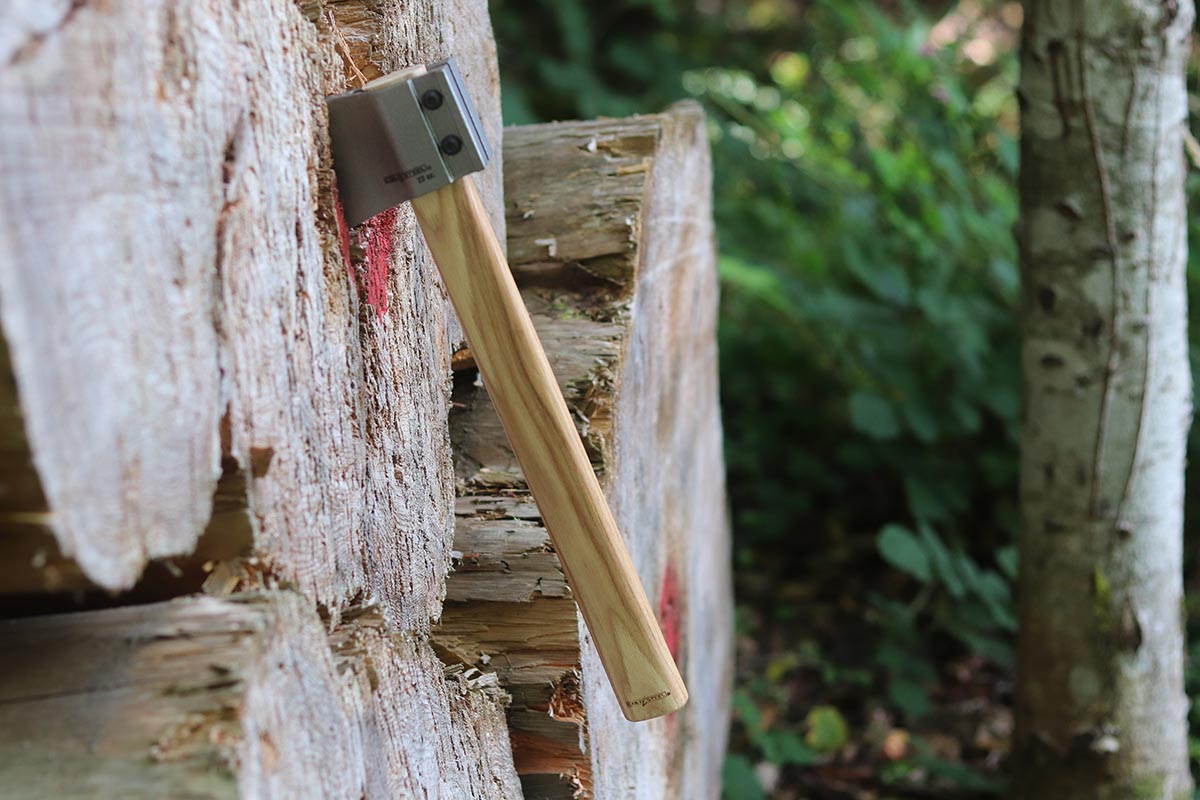
Our Top Picks
Our testing revealed the features that help make an axe qualify as one of the best on the market. Handle length, head weight, and overall design determine how easy and convenient an axe is to use. In testing, we found that many of our favorite axes are made by brands with a long industry history and the knowledge and experience to create well-honed products. Still, some designs are better for certain types of tasks, such as making kindling or splitting large wood rounds. We tested each of the following axes to determine if they held up to the manufacturers’ promises and see how well they worked in action.
Best Overall
Fiskars X27 36-Inch Super Splitting Axe
What We Like
- Long handle works well for taller users and creates good swing force
- Head weight helps build momentum and power to maximize effectiveness
- Fiskars’ proprietary blade-grinding technique produces a sharp blade that cuts through rounds easily
What We Don’t Like
- May be too long and heavy for shorter users and those with limited upper-body strength
- Requires strength and practice to learn to control
Product Specs
- Length: 36 inches
- Head weight: 6.3 pounds
- Handle material: Fiberglass composite
For the power and velocity that only a long-handle axe can deliver, look no further than the Fiskars X27 Super Splitting axe. At 36 inches long and 6.3 pounds, it requires strength and coordination to swing, but once the blade strikes, it leaves a decisively powerful cut.
The Fiskars axe doesn’t have a full maul head, but you can use the back side to drive a splitting wedge if needed. The handle, manufactured from a fiberglass composite, absorbs some of the shock of each strike, reducing wear and tear on your arms. It also has a slightly textured but comfortable feel and flared end to help you maintain a firm grip.
During testing, this model performed beautifully. One of our testers owns an older model of the X27 that’s lasted 15 years despite regular use. This latest rendition felt just as good and didn’t disappoint.
What our tester says: “It’s a heavy axe that takes strength and skill to control. However, with a little practice, I found that the X27 could take on large rounds that other axes fail to tackle.”—Stacey L. Nash, Product Reviews tester & writer
Get the Fiskars X27 axe at Amazon, The Home Depot, Walmart, or Blain’s Farm & Fleet.
Best Bang for the Buck
Estwing 14-Inch Fireside Friend Splitting Tool
What We Like
- Small size makes it easy to store and stow
- Secure, durable nylon sheath protects the head when not in use
- Heavy head can split wood, create kindling, or drive wedges and stakes as needed
- Single-piece forged-steel design adds durability
What We Don’t Like
- Heavy head can tire the wrist
- Not designed for larger splitting work; suitable for light-duty tasks only
Product Specs
- Length: 14 inches
- Head weight: 4.3 pounds
- Handle material: Forged steel wrapped in rubberlike material
There’s no need to struggle with a large axe when the Estwing Fireside Friend 14-inch axe is powerful enough to effortlessly split chunks of wood into smaller pieces or make kindling. The Estwing features forged-steel construction and a maul head for driving splitting wedges.
The Estwing’s handle is wrapped in a rubberlike material that absorbs shock and provides a comfortable grip. Aeration holes offer breathability and add a grippy texture, too. This axe’s small size makes it a great choice to keep on a hearth for quick splitting or to take camping to clear a site, make kindling, and split a few small rounds.
We like that the Estwing balances functionality with price. It’s not the type of axe used to split wood daily, but it works beautifully in a pinch and for light-duty tasks. It’s easy to store behind the seat of a truck or tuck away in camping gear, so you always have a cutting tool on hand. While it isn’t the most elegant axe/hatchet we tested (the heavy 4.3-pound head could easily get out of control), it’s perfect for driving wedges, pounding tent stakes, or taking out brush.
Get the Estwing axe at Amazon, Lowe’s, or Walmart.
Upgrade Pick
Gransfors Bruks Outdoor Axe
What We Like
- Incredibly sharp head easily chops and splits hard- and softwood
- Light weight makes it easy and fast to swing, offering excellent accuracy
- Impressive quality and craftsmanship that can be handed down from one generation to the next
- Head design allows for handheld detail work for diverse uses
What We Don’t Like
- Comes at a higher price than more utilitarian options
Product Specs
- Length: 14.57 inches
- Head weight: 1 pound
- Handle material: Hickory wood
Gransfors Bruks enjoys a well-deserved reputation as a premier maker of axes and hatchets, and its outdoor axe goes beyond expectations of what an axe or hatchet can be. The tight-grained hickory wood handle is lightweight but feels stable and fits well in hand. A lightweight 1-pound head may not sound like it would split well, but it’s deceptively sharp—so sharp, that if we rated it on a scale of 1 to 10 for sharpness, it would get an 11.
That sharpness comes into this axe’s true strength: fine detail work. The Gransfors Bruks can function as a traditional axe as well as a woodworking tool to carve and create furniture and art. The handle and head design offered excellent control, and the sharp head dug into the wood with every swing. We also tried it as a woodworking tool by scraping and carving a piece of wood. The head, which can be held in hand for better control when doing fine work, moved through the block of wood like soft butter. It’s a beautiful axe that makes others pale in comparison. However, the small size makes it better for splitting kindling than large rounds.
What our tester says: “It only took a few swings for me to fall in love with this axe during the testing process. It may come with a high price, but it outshines any of the other models we tested.”
Get the Gransfors Bruks axe at Amazon.
Best with Wood Handle
Husqvarna 26-Inch Swedish-Style Multipurpose Axe
What We Like
- Light weight allows for continuous long-term use with 1 or 2 hands
- Excellent materials and construction make it a showy but functional axe
- Durable leather sheath protects the blade from knicks and the user from cuts
- Well-oiled tight-grained handle adds strength and durability
What We Don’t Like
- Length is too short for bigger splitting jobs; best for small-scale jobs only
- Head seemed duller than some of the other axes we tested
Product Specs
- Length: 26 inches
- Head weight: 1.87 pounds
- Handle material: Hickory wood
When only the feel of a real wood handle will do, check out the Husqvarna 26-inch wooden multipurpose axe. Husqvarna might be best known for its chainsaws and lawn mowers, but the brand performs with this manual cutting tool, too. This model features a 26-inch tight-grained hickory handle that’s smooth to the touch and feels solid and strong in the hand.
The Husqvarna doesn’t have a maul head, but the back side can function as a hammer to drive a splitting wedge or tent stake if needed. The 1.87-pound head is lighter than most, but it’s well balanced, so needed momentum easily builds. In testing, the light weight was an asset because the axe is balanced in a way that makes each strike effective. The thoughtful design of this tool makes it easy to use single or double handed, depending on the job.
This model from Husqvarna comes with a leather cover that protects the blade and keeps it from damaging anything around it with its sharp edge. It’s definitely the kind of axe to keep along on a hunting or camping trip for any splitting or chopping jobs that arise.
Get the Husqvarna axe at Amazon, Walmart, or Husqvarna.
Best Hatchet
Hults Bruk Almike All-Purpose Hatchet
What We Like
- Comfortable curved handle maximizes the force of each strike
- Design offers excellent control without fatiguing the wrist, arm, or shoulder
- Durable leather sheath protects axe-head from damage while transporting or storing
- Slight imperfections show handmade construction, giving the hatchet added character
What We Don’t Like
- Not efficient for large rounds or a high splitting volume
Product Specs
- Length: 16 inches
- Head weight: 1 pound
- Handle material: Hickory wood
The Hults Bruk Almike hatchet provides ample splitting power in a small package. It also carries the Hults Bruk name, known for forging quality axes since 1697. This model features a 16-inch curved hickory handle with a tight grain that adds strength and beautiful oiling that maintains the wood and adds visual appeal.
This model is incredibly comfortable in hand, and its svelte 1-pound head balances the design. While it may be lightweight, the combination of the handle design and head weight makes it easy to swing over and over again. Its sharp edge easily glides through wood, allowing for efficient splitting with minimal effort.
The ability of the Hults Bruk to split logs was surprising since hatchets aren’t usually the most efficient option for this task. Yet we found its design highly effective for splitting and making kindling. The Hults Bruk is on the pricey side for a hatchet, but it’s the type of tool that will get passed down and maintain its functionality.
What our tester says: “I didn’t get tired when using it, and I got incredible accuracy with each swing.”
Get the Hults Bruk axe at Amazon or REI.
Best Splitting Maul
Fiskars Pro 36-Inch IsoCore Wood Splitting Maul
What We Like
- Heavy head splits large wood rounds, even those with knots and branches
- Wide sledge side makes it easier to hit a splitting wedge, driving it deeper for quicker splitting
- Handle design makes it more comfortable to hold and absorbs vibration to reduce fatigue
What We Don’t Like
- Heavy head is overkill for everything but the toughest, largest rounds
Product Specs
- Length: 36 inches
- Head weight: 8 pounds
- Handle material: Fiberglass composite
Fiskars knows axes, and the IsoCore splitting maul can take on those large wood rounds that make other axe-heads bounce like a rubber ball. A sturdy 36-inch handle made of a vibration-reducing composite keeps it comfortable while pounding through knots and other tough spots.
We used this 8-pound axe for the most difficult tasks we could find. Even large rounds filled with knots and branches (that typically require a chainsaw to split) were no match for this maul. The head has a blade on one side and a sledgehammer on the other for splitting wedges. The sledge side is also nice and wide, making it easier to hit the target. Plus, the added weight of the head drives the wedge in deep for a better, faster split.
While its weight goes above the more comfortable 5- to 6-pound heads, the extra pounds give it the power to build momentum that hardwoods and large rounds require. Just keep in mind that the weight is overkill for everything but the thickest, toughest, largest wood rounds. And it will be too heavy for those with limited upper body strength.
Get the Fiskars IsoCore axe at Amazon, Lowe’s, Tractor Supply Co., The Home Depot, Walmart, or Fiskars.
Best Throwing Axe
Cold Steel Professional Throwing Axe
What We Like
- Head only requires an Allen wrench for removing, loosening, or tightening
- Excellent weight-to-length balance for precise throwing
- 4-inch blade meets axe-throwing tournament requirements
What We Don’t Like
- Could have issues finding a replacement handle
Product Specs
- Length: 16 inches
- Head weight: 1.31 pounds
- Handle material: Hickory wood
The sound of an axe embedding in a wood target is hard to beat, which is just one reason that axe throwing has grown in popularity. The Cold Steel professional throwing axe is designed and balanced to maximize accuracy and comfort for serious (or casual) axe competitions. It features a solid hickory handle that comfortably fits the average hand. At 16 inches, it’s the perfect length for throwing.
One of our favorite features of this throwing axe is the removable axe-head. It has two screws that loosen or tighten with an Allen wrench so you can replace a worn-out handle without replacing the entire axe. The head on our axe was a bit loose when it arrived, but we easily adjusted it and started throwing.
The axe’s 21-ounce head weight enhances its throwing ease by creating the right momentum for establishing a comfortable rhythm. The head isn’t sharp since throwing doesn’t require it, yet the axe stuck hard in a cedar round. A 4-inch carbon-steel blade meets the requirements for axe-throwing tournaments, so this is an excellent option for both practice and competitions. The only issue we could see is that some hard-core users have had trouble finding replacement handles.
Get the Cold Steel axe at Amazon, The Home Depot, or Cold Steel.
Best Brush Axe
Woodman’s Pal Multiuse Axe
What We Like
- Versatile head design makes it usable for splitting, chopping, and cutting brush
- Blade holds a sharp edge even after heavy use
- High-quality leather sheath protects the blade and lets you attach the axe to your belt
What We Don’t Like
- Its price tag is higher than many options on our list, which makes it more of a long-term investment
Product Specs
- Length: 17 inches
- Head weight: 1.31 pounds
- Handle material: Ash wood or leather
The Woodman’s Pal multiuse axe comes with a high price tag, but it also comes with impressive craftsmanship and a versatile design. The head, made of spring steel, features a sharp axelike side and a sickle-hook side, making it incredibly useful for clearing brush. During testing, the sickle easily sliced through small branches and overgrown shrubs. That side also features a safety notch that prevents your hand from sliding into it, but remember never to hold any axe by its blade.
You can purchase the Woodsman’s Pal with one of two handle designs: wood or leather with a knuckle guard. In our tests, we used the wood-handle version since one of our testers already owns a leather-handle one. After using both, our tester preferred the leather handle because of the additional safety provided by the knuckle guard. However, they liked that the wood handle offers extra grip from ergonomic finger grooves. Our tester with small hands found that the lower three finger grooves fit well, but there’s also a fourth and larger finger groove for those with larger hands.
No matter which handle you choose, you’ll find that the Woodsman’s Pal cuts through brush and branches with little effort. You can also use it to split firewood and cut down small trees. It handles these tasks with ease and comes with a sharpening stone and protective leather sheath.
Get the Woodman’s Pal axe at Amazon or Woodsman’s Pal.
Best Survival Axe
Camillus Camtrax 3-in-1 Hatchet
What We Like
- Lightweight handle and head are easy to pack and transport
- Plastic sheath securely clips to a belt or backpack
- 3-in-1 design offers versatile uses in unexpected situations
What We Don’t Like
- Saw-blade release can dig into the hand when using the tool as an axe
Product Specs
- Length: 12 inches
- Head weight: 2.03 pounds (entire hatchet weight)
- Handle material: Glass-filled nylon
In survival situations, lightweight, multipurpose tools offer the best versatility, and the Camillus Camtrax axe and folding saw’s three-in-one design is valuable in a pinch. At just over 12 inches long, it’s easy to throw in an overnight pack or pickup truck before heading into the mountains for a few days. Plus, it comes with a plastic head cover that snaps into place and attaches to a backpack or belt.
The compact head of this survival axe works for chopping small trees or limbs and making kindling. The saw, which folds into the handle, can cut small limbs or trees too, which it did during testing (with a little muscle power behind it). A hammerhead on the axe-head’s back side provides the final piece of the survival tool’s trifecta of uses.
During testing, this model performed adequately in all three functions—as an axe, saw, and hammer. Like similar multipurpose tools, a tool dedicated to a single purpose can perform better. But it works beautifully when you don’t have all your tools at your disposal. Our only complaint is the placement of the saw release, which is on the back side of the handle. When using the Camillus as an axe, that portion of the saw cuts into the hand. Wearing gloves helps, but if you’re doing a lot of chopping or splitting, that design could be an issue.
Get the Camillus axe at Amazon, The Home Depot, Camillus, Sportsman’s Warehouse, or Bass Pro Shops.
Best Felling Axe
Fiskars 28-Inch Chopping Axe
What We Like
- Comfortable handle with shock-absorbing textured grip and flared end
- Ideal length and balance that supports the power necessary for felling trees
- Low-friction coating helps prevent blade from getting stuck in trees
What We Don’t Like
- More of a specialized tool; not as versatile as other splitting mauls, axes, or hatchets
Product Specs
- Length: 28 inches
- Head weight: 3.8 pounds
- Handle material: Fiberglass composite
A felling axe needs to dig deep into wood but doesn’t necessarily need the long handle of a splitting axe or maul. For those times a chainsaw isn’t at hand, the Fiskars 28-inch chopping axe fits the felling bill. The Fiskars’ durable fiberglass composite handle feels solid and strong while absorbing the shock of each strike and reducing vibration. Texture near the handle’s end adds grip, and the end also flares to help keep your hands in place while you work.
This axe was a superstar during overall testing, but it really excelled when felling trees. Its head-handle balance helped it stay in control and accurate while building momentum. The head dug into the wood, providing more progress with every strike. It’s also covered in a low-friction coating that makes it easier to pull the axe from the wood.
The protective sheath that comes with this axe locks in place, and we found that feature made it easier to store that axe without worrying the cover would slip off. The sheath protected the head from nicking other items and kept the head from getting nicked or scratched by anything nearby. Our only issue with this model is that it’s very project and job specific. The handle is a bit short for splitting, yet it’s too big for making kindling and limbing trees. But if you need an axe that can take down a tree, this is the right tool for the job.
Get the Fiskars chopping axe at Amazon, Walmart, or Fiskars.
Jump to Our Top Picks
How We Tested the Best Axes
Swinging an axe is hard work, but a well-designed tool makes that work more manageable. We scored each axe on performance and efficiency and noted their handle length and head weight. These measurements play into an axe’s balance, which greatly influences how well and how long they can be used. We rated each axe for usefulness and whether or not we would want to swing it again. Wrist fatigue factored into ease of use as well.
We tested the axes using an established rubric—splitting at least five pieces of wood and making kindling with each one. If the axe had a specialty design, we also tested that axe within its specialty—felling trees, throwing at targets, or doing some woodworking.
What to Consider When Choosing an Axe
Axes come in a variety of shapes and sizes, designed to do everything from felling trees and trimming branches to shaping wood for sculptures. However, not all axes are suitable for splitting firewood. Splitting is the process of striking the flat sawed end of a short log to separate the wood fibers, which causes the log to split apart along its grain. The two main types of axes used to harvest wood are splitting and felling, and when you’re trying to split wood, you likely don’t want to use a felling axe. In a pinch, you can also split wood with a hatchet.
Type
- A splitting axe is sometimes called a splitting maul. However, a splitting maul is actually slightly different. A maul typically has a wedge-shaped head with a back side that looks like a sledgehammer. Most often, the blade side is adequate for wood splitting, but for a large log that’s a foot or more in diameter, the splitting power can be increased by positioning a splitting wedge—a long, narrow steel wedge—into the face of the log and using the maul end as a sledgehammer to hit it. (Check out step-by-step instructions on splitting logs.)
- A splitting axe features a large, heavy steel head (traditionally, these heads were made with iron) with a sharp wedge-shaped blade that can split a log along the wood grain when struck decisively in the center. Splitting axes don’t have the “maul” side of the head, though they may have a flat side that can function as a hammer.
- A felling axe, also called a chopping or forest axe, has a lighter head than a splitting axe. These models are designed to chip away at a standing tree using horizontal strokes. When shopping for a splitting axe, steer clear of these axes because they’re not designed to split wood along its grain.
- A hatchet looks like an axe, except it has a shorter handle, usually 12 to 18 inches long. Hatchets are used for fine detail work, limbing, small splitting jobs, and sometimes felling small trees. They’re not necessarily great for splitting, but they can be used to make kindling or break apart smaller pieces of wood if needed.
Axe Handle
Splitting axe handles are made of one of three materials: hardwood, fiberglass composite, or forged steel that’s covered with rubber or a similar material.
- Wood axe handles are popular because they’re relatively lightweight and feel good to the touch. Wood also absorbs shock, but wood handles can weaken and break over time, requiring replacement. Wooden handles with a tight grain that runs parallel to the direction of the blade offer the best strength and durability.
- Fiberglass composite handles are smooth to the touch and will absorb some shock, but fiberglass has a tendency to shatter if used in subzero temps. It can also break if a misstrike happens and the shaft is hit instead of the head on the wood.
- Steel axe handles are often forged in a single piece that combines both the axe-head and the handle. These are the most durable choice, but they don’t absorb shock, so your hands may fatigue faster. Handles covered in rubber or a similarly absorbent material will reduce the shock that goes through your hands.
Length
When choosing an axe, the length of the handle is just as important as what it’s made from. Handle lengths run from 14 inches up to 36 inches. The longer the axe, the more velocity and power it can generate.
Just remember that hitting a precise spot on a log becomes slightly more difficult with a longer handle. Those just starting will want to consider an axe with a 31-inch handle. You may want to transition to a longer handle as your technique improves. Axes with shorter handles are often designed for use with one hand and are best for splitting kindling.
Weight
The heavier the axe-head, the more power it can generate when swung in an arc and brought down onto the log. However, if the head is too heavy to control, it may throw off the aim and tire out the user after a few swings.
Standard splitting axes come with heads that weigh between 3 and 6 pounds. Mauls, with sledgehammer-type heads, can weigh as much as 8 pounds. Unless the plan is to compete in wood-splitting competitions, it’s usually best to go with an axe-head that weighs 4 to 6 pounds. Hatchet heads are lighter, typically 1.5 to 3 pounds.
FAQs
A shiny new axe doesn’t come without a learning curve. If you’re new to splitting, you may have more questions. To make it easier, we’ve answered a few popular questions to ensure you’ve got the right axe for your needs and know how to take care of it.
If you use the axe frequently, you may need to sharpen it regularly. Watch for signs of rust because nicks are fairly common. To prevent rust, oil the head before putting it in the sheath. Wood-handled axes may also need periodic oiling to maintain the strength and appearance of the wood.
Splitting mauls are generally larger and have a head that can act as a hammer or be hammered once it’s wedged in a large round. Splitting axes typically have sharper heads and don’t have the maul head. They might have a flat back side for hammering and a shorter handle. A splitting axe offers more versatility if you need an axe for more than splitting. Hatchets are shorter than either splitting mauls or splitting axes. They’re a good choice if you only need to split occasionally because they’re easier to store and swing.
If the only thing you’re doing is splitting, a splitting maul or splitting axe works best. Splitting mauls are more efficient for large rounds, but their weight and length require strength and practice. If you need an axe that’s close to a maul without the heavy maul head, take a look at the Fiskars X27 Super Splitting Axe. Splitting axes aren’t as efficient on large rounds but work well for splitting standard rounds, making kindling, and using for general purposes.
Why Trust Bob Vila
Bob Vila has been America’s Handyman since 1979. As the host of beloved and groundbreaking TV series including “This Old House” and “Bob Vila’s Home Again,” he popularized and became synonymous with “do-it-yourself” home improvement.
Over the course of his decades-long career, Bob Vila has helped millions of people build, renovate, repair, and live better each day—a tradition that continues today with expert yet accessible home advice. The Bob Vila team distills need-to-know information into project tutorials, maintenance guides, tool 101s, and more. These home and garden experts then thoroughly research, vet, and recommend products that support homeowners, renters, DIYers, and professionals in their to-do lists.
Meet the Tester
Stacey L. Nash has written about home and garden products, home design and decor, and general indoor and outdoor home improvement for 5+ years. She’s passionate about research and hands-on testing to find the products that add true value to homeownership and daily life. She lives on 12 heavily wooded acres, where she and her family put home and outdoor products to the test while avoiding bears and cougars.
Additional research provided by Glenda Taylor.
